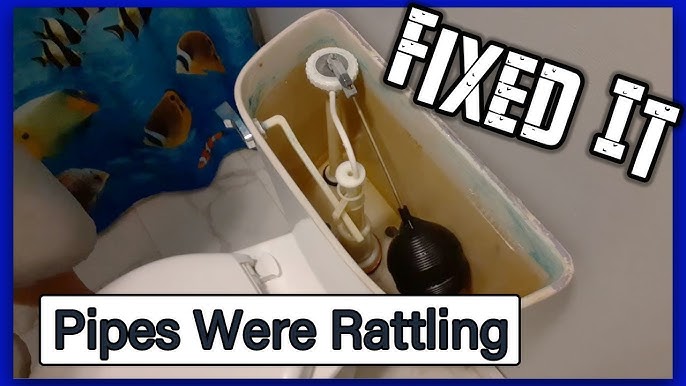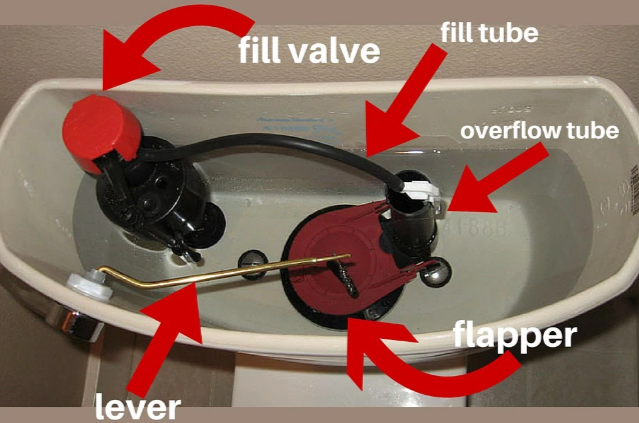Does your toilet sound like it’s about to launch into orbit every time you flush it? That loud vibrating noise can be more than just an annoying disruption; it could be a sign of underlying plumbing issues.
You’re not alone in facing this problem, and understanding what’s causing it can save you from potential headaches and costly repairs down the line. Imagine enjoying a peaceful home environment without the sudden roar of a flushing toilet. Intrigued? Stick with us as we unravel the mystery behind that unsettling noise and reveal simple solutions to restore tranquility to your bathroom experience.

Credit: www.youtube.com
Causes Of Loud Vibrating Noise
Experiencing a loud vibrating noise when flushing the toilet can be quite unsettling. This noise often indicates an underlying issue that needs attention. Understanding the causes helps in resolving the problem efficiently.
Water Hammer Effect
The water hammer effect is a common cause of noise. It occurs when water flow abruptly stops or changes direction. This sudden stop creates a shock wave, causing pipes to vibrate and produce noise. Over time, this can damage plumbing if not addressed.
High Water Pressure
High water pressure can also lead to loud noises. Excessive pressure forces water to rush through pipes too quickly. This rapid flow causes vibrations and noise. Ensuring water pressure is within normal limits can help prevent this issue.
Loose Or Worn Parts
Loose or worn parts within the toilet can cause vibrations. Components like the fill valve or flapper may become worn over time. These worn parts can vibrate and create noise during flushing. Regular maintenance checks can help identify and fix these issues promptly.

Credit: www.youtube.com
Water Hammer Solutions
Experiencing a loud vibrating noise when flushing your toilet can be annoying. This issue, often caused by water hammer, disrupts your peace. Installing water hammer arrestors or securing loose pipes can effectively eliminate this problem.
Dealing with a loud vibrating noise when flushing your toilet can be frustrating. This phenomenon, often known as “water hammer,” isn’t just noisy—it’s a sign of underlying plumbing issues that could cause damage over time. But don’t worry, there are practical solutions to tackle this problem and restore peace to your bathroom.Install Water Hammer Arrestors
Water hammer arrestors are devices designed to absorb the shock of fast-moving water in your pipes. Installing them can significantly reduce the noise. They work like a shock absorber in your car, smoothing out the pressure fluctuations. Picture this: You’ve just flushed the toilet, and a thunderous clatter reverberates through your home. This was my morning wake-up call until I added water hammer arrestors. They can be easily installed on the water supply lines. You don’t need to be a plumbing expert, but if you’re unsure, a plumber can help. Have you ever wondered if such a simple device could make such a big difference? It does, and it’s worth considering for a quieter home.Adjust Water Pressure
High water pressure is a common cause of water hammer. It can cause pipes to rattle and make that unsettling noise when you flush. Checking and adjusting your water pressure can be a straightforward solution. You can use a water pressure gauge to measure the pressure in your home. Ideally, it should be between 40-60 psi. If it’s too high, you can adjust it using a pressure-reducing valve. When I first measured my home’s water pressure, I was surprised to find it was much higher than recommended. Adjusting it not only reduced the noise but also helped in conserving water and reducing wear on plumbing fixtures. Have you checked your water pressure lately? It might just be the key to solving your noisy toilet issue. Don’t let a loud flush disturb your peace. These solutions are practical, and implementing them can make a world of difference in your daily life.Addressing High Water Pressure
Experiencing a loud vibrating noise while flushing the toilet often signals high water pressure. This pressure can harm pipes, causing annoying sounds and potential damage. Installing a pressure-reducing valve helps to manage this issue effectively.
Experiencing a loud vibrating noise when flushing your toilet can be annoying. One common reason for this noise is high water pressure. High water pressure can cause pipes to vibrate, leading to an unpleasant sound. By addressing the water pressure issue, you can restore peace in your bathroom.Check Pressure Regulator
A pressure regulator helps manage water pressure in your plumbing. Check if your home has a pressure regulator installed. Locate the regulator near your main water supply. If you find one, check its settings. Ideally, household water pressure should be between 40 and 60 psi. Use a gauge to measure the current pressure. Adjust the regulator to keep it within the recommended range. If unsure, consult a professional plumber for assistance.Install Pressure Reducing Valve
Installing a pressure reducing valve can help control high water pressure. This valve reduces the pressure entering your plumbing system. It ensures a steady and safe water flow. Hire a licensed plumber to install the valve. They have the skills to fit it correctly. After installation, monitor the water pressure levels. Ensure they remain within the safe range. Regular checks prevent future plumbing issues and noise disturbances. `Fixing Loose Or Worn Parts
Experiencing loud vibrating noise when flushing the toilet can indicate loose or worn parts. Tightening bolts or replacing washers may help resolve the issue. Ensuring all components are secure can prevent further noise and maintain proper toilet function.
A loud vibrating noise when flushing your toilet can be annoying, but it’s often a sign of loose or worn parts. Addressing these issues can make a world of difference in your bathroom experience. You don’t have to be a plumber to tackle these common problems. With a little patience and the right tools, you can fix them yourself. Here are some practical steps to get started.Inspect Fill Valve
Start by checking the fill valve. This part regulates the water level in the tank. A loose or malfunctioning valve can cause vibrations. Turn off the water supply to the toilet. Flush to empty the tank, then remove the lid. Examine the fill valve for any visible signs of damage or wear. Gently wiggle it. If it moves too much, it might be loose. Tighten any screws or nuts holding it in place. Consider replacing it if it appears worn out or damaged beyond a simple fix.Replace Worn Washers
Washers can deteriorate over time, leading to leaks and noises. If you hear a persistent vibrating sound, worn washers might be the culprit. Drain the tank and disconnect the water supply. Remove the fill valve and check the washers. If they look cracked or misshapen, replace them with new ones. Ensure they are securely fitted to prevent future leaks.Tighten Tank Bolts
Loose tank bolts are another common source of noise. These bolts connect the tank to the bowl. If they’re not tight enough, vibrations can occur. Feel around the bottom of the tank for the bolts. Use a wrench to gently tighten them. Be careful not to overtighten as this can crack the porcelain. After tightening, flush the toilet and listen. Is the noise gone? If so, you’ve likely solved the problem. Have you ever noticed that fixing things yourself gives a sense of accomplishment? Tackling these issues not only silences the noise but also boosts your confidence in handling minor home repairs. Give it a try and see how satisfying it can be.Diy Vs Professional Help
When faced with a loud vibrating noise when flushing your toilet, you might wonder whether you should tackle it yourself or call in a professional. It’s a common dilemma for homeowners. You want to save money, but you also want the problem fixed correctly. By weighing your options, you can make an informed decision that suits your situation.
When To Call A Plumber
Some toilet issues are straightforward, while others can be complex. If you’ve tried basic troubleshooting like tightening loose bolts or checking the water supply without success, it might be time to call a plumber. Persistent noises could indicate problems in the plumbing system that require specialized tools and expertise.
Think about your comfort level with DIY repairs. Are you confident in your skills, or do you dread the thought of dismantling your toilet? If the latter, a plumber’s expertise can be invaluable. They can quickly diagnose and fix the problem, giving you peace of mind.
Cost-benefit Analysis
Repairing your toilet yourself might save you the cost of hiring a plumber, but consider the potential risks. If a DIY attempt goes wrong, you could end up with more damage and higher costs. Professional repairs might seem pricier upfront, but they often save money in the long run.
What value do you place on your time? DIY projects can be time-consuming. If your weekends are precious, you might prefer to invest in professional help and spend your time on things you enjoy. Weighing these factors can help you decide which path to take.
Ultimately, the choice between DIY and professional help depends on your skills, time, and budget. Have you ever tackled a plumbing issue yourself? Share your experiences and insights in the comments below. Your tips might help others facing the same noisy dilemma!
Preventive Measures
To prevent loud vibrating noises when flushing a toilet, check for loose parts. Tighten any loose screws or connections. Ensure water pressure is at an optimal level. Regular maintenance can help keep your toilet quiet and efficient.
Preventing loud vibrating noises when flushing a toilet enhances home comfort. By adopting simple preventive measures, you can ensure a quieter bathroom experience. Regular maintenance and smart upgrades can keep your toilet functioning smoothly.Regular Maintenance Tips
Regular maintenance is vital for a quiet toilet flush. Check for loose pipes. Tighten any connections that seem unstable. Inspect the fill valve for wear. Replace it if necessary. Keep the toilet tank clean. Sediment buildup can cause noise. Use a gentle cleaner regularly. Ensure the flapper seals properly. A faulty seal can lead to vibrations. Listen for unusual sounds during flushing. Address issues promptly to prevent bigger problems.Upgrading Toilet Components
Upgrading toilet components can reduce noise significantly. Consider a modern fill valve. Newer models operate more quietly. Replace old washers and seals. They can wear out over time. Opt for a pressure-assisted toilet. These models flush more efficiently. Install a quiet fill valve. It can minimize sound during refill. Invest in a quality toilet flange. It can stabilize the toilet and reduce vibrations. Check compatibility before purchasing parts. Proper fit ensures optimal performance.
Credit: plumbers-maidstone.co.uk
Frequently Asked Questions
What Causes A Toilet To Make A Loud Noise When Flushed?
A worn-out fill valve or loose pipes often cause this noise. Fixing or tightening them helps.
How Can I Stop The Vibrating Noise In My Toilet?
Check and replace the fill valve. Secure loose pipes. These steps should reduce noise.
Is A Vibrating Toilet A Sign Of A Serious Problem?
Usually, it’s not serious. Often, it’s due to minor issues like a faulty valve.
Can A Plumber Fix My Noisy Toilet?
Yes, a plumber can identify the cause and fix it. They ensure everything works smoothly.
Why Does My Toilet Only Make Noise Sometimes?
It might be due to water pressure changes. Or, parts may be worn out. Regular checks help.
Conclusion
Solving toilet noise issues is simpler than it seems. Check your toilet parts. Ensure they are tight and well-fitted. Replace worn-out parts promptly. Consider professional help for complex problems. Regular maintenance can prevent future issues. Keep your toilet functioning smoothly.
A quiet bathroom improves home comfort. Understanding the cause helps in finding solutions. Avoid stress over plumbing problems. You now have the tools to address loud noises. Your toilet can flush quietly once more. Enjoy peace in your home.




